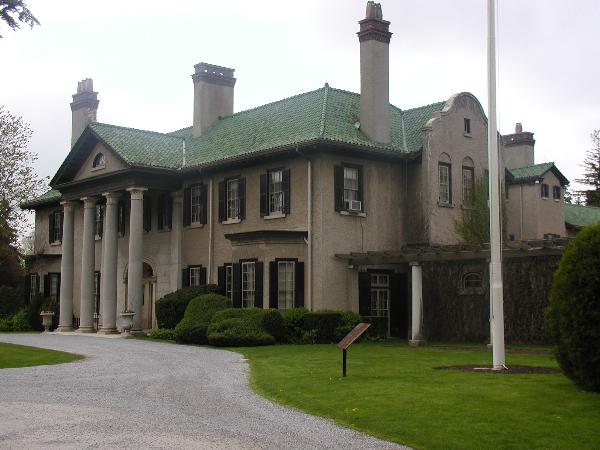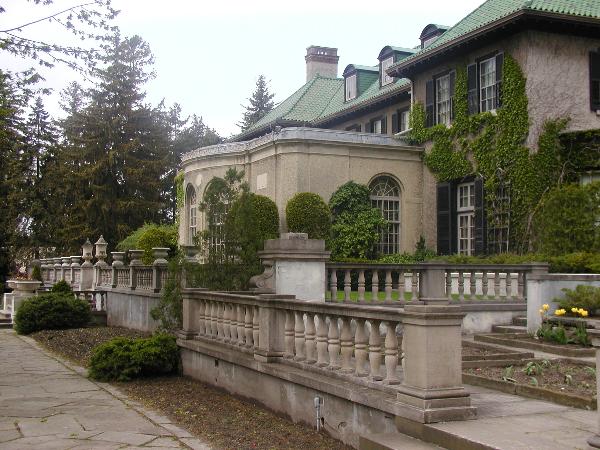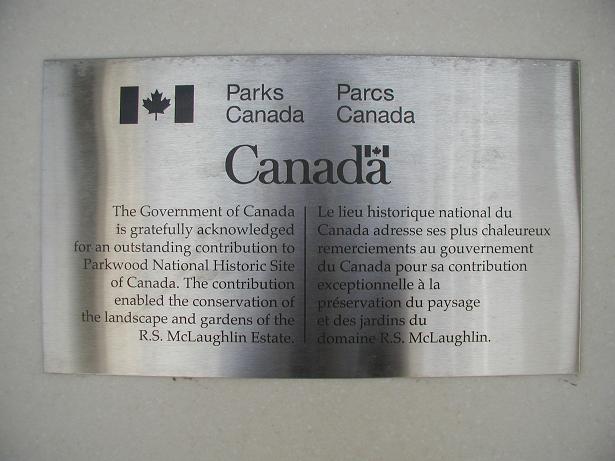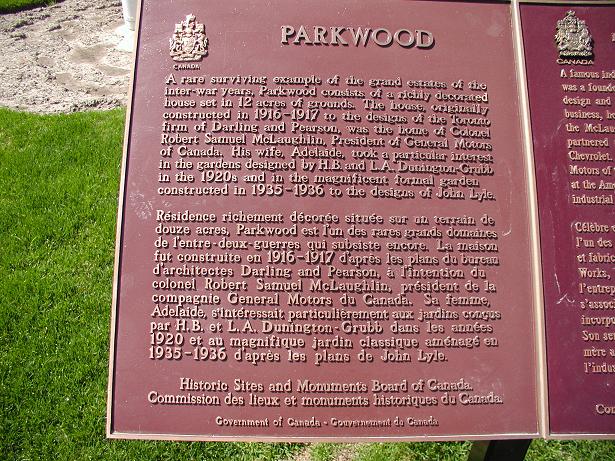

Parkwood was the home of Colonel R.S. McLaughlin.
Sam McLaughlin, the founder of General Motors of Canada, built the house and garden with his wife Adelaide. The architectural design (by Darling and Pearson) is typical of the Country Place Era - 'Golden Age Beaux Arts', with a very grand conservatory.The gardens were designed by landscape architects HB and LA Dunington Grub in the 1920s, with Arts and Crafts lawns, pavilions, paths and statues. There is also a 2-acre 'art moderne' Formal Garden, made in 1935, and an indoor 'Japanese Garden'

Parkwood’s driveway is well hidden between the trees and gates, but after entering, the front of the estate comes into view as a vision. Four pillars at the front door, a nicely kept garden in the front. Even with it’s magic, this is but the top of the iceberg.
Visitors drive their cars around to the stables, or walk in via the same way, and have a choice then and there. Enter through the giftshop, or explore the amazing gardens, which have been brought back to their original state.
The Gardens:
The many “rooms” of the Parkwood Gardens all breathe their own ambience. From a quiet little corner, and a sunken tennis court, one walks under a small arch cut out of the hedges, and before you know it, you witness what some might consider worthy of teary eyes. Stairways winding down to a garden of fountains, sculpted lions spewing water, and high reaching pillars of silvery liquid, greet the onlooker. At the end of all this is the teahouse, in art deco style, where freshly made lemonade, tea, and cakes are served. Romance is alive in this garden.
Once leaving this Tearoom, walking between the squirrels, you might stumble upon the little treasures in the adjoining garden. A modest open-air theatre, where statues look down from their pedestals. And leaving this nook of the gardens, one is treated to the side of the Estate, a direct view on the Garden Room. There are other gardens, but they are more like rooms of Parkwood itself. Which brings us to the building.
The House:
The house itself is nothing less than magical. The interior the most modern one can imagine at the time, was still soaked with history. Paintings, also done by one of Sam’s daughters, antiques from all over the world, and items that have become antiques during their stay in this small palace adorn the rooms and hallways.
Visitors enter through the giftshop, where small items can be purchases, and groups, or even just one person, can get ready for the tour. This tour takes one on a trip throughout the house, save for the servants quarters: nothing is to be seen there, as all servants, upon leaving, were allowed to take the furniture to their new house. The rest of the house however, is full of knick-knacks and art, inlaid cabinets and beds.
Parkwood was one of the first houses to have remote control: The grand staircase hides the pipes of an organ, which could be controlled by remote. The house also had it’s own telephone switchboard, secret passageways, and a hidden radio. Sam didn’t want his library to be violated by speakers, so those were hidden behind a facade of books. Nothing was too good for this house. A Steinway piano was ordered and shipped out to Europe, so be adorned with a great landscape painted on its wing.
Parkwood is more roomy than the outside would suggest, and the outside does suggest an already big interior. But, it was big enough to have a bowling alley, an indoor swimmingpool with changingrooms, a aforementioned library, and numerous private bathrooms (naturally all installed with the “newest of the new” equipment and gadgets), as well as guestrooms, a spacious kitchen with a large variety of bone china (Royal Doulton and the like are on display), and an impressive billiards room. One of the gardens which are closed off from the publicly accessible gardens is one where the Three Graces reside: the Italian garden was Sam’s private one, where he could go for a stroll if work in the library became too much. A small fountain and symmetrical flowerbeds form a small oasis for Sam alone. The conservatory and a small tea-room there are also only accessible through the house, which practically made them flowery rooms like the rest of the house.
Present:
In this day and age, Parkwood is as vibrant as it was in its supposed glory days. In the opinion of most, the glory days never ended: time stood still, one can’t hear the streets in the gardens nor the house due to the sound barriers the trees form, so they’d believe they’re still in the impressive, more relaxed era Sam started to build the Estate in. Employers from the Oshawa General Hospital, next to the Estate, take their lunch breaks here. Over Easter there is an egghunt, and a “lighting of the tree” draws people to Parkwood in the dark days before Christmas. Movies are shot here, and Parkwood is no stranger to the likes of Sean Connery and other great actors, actresses, and the hubbub of film crews. Parkwood lives on.

For more information on
The R.S.MCLAUGHLIN 'PARKWOOD' NATIONAL HISTORICAL ESTATE and it's present day functions are available on this web-site.
